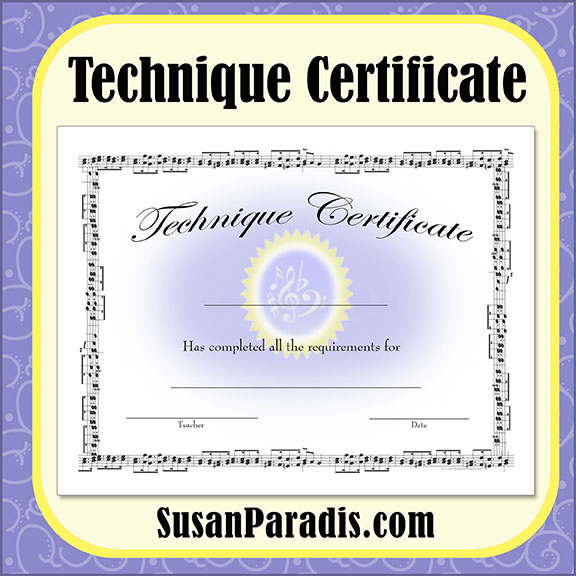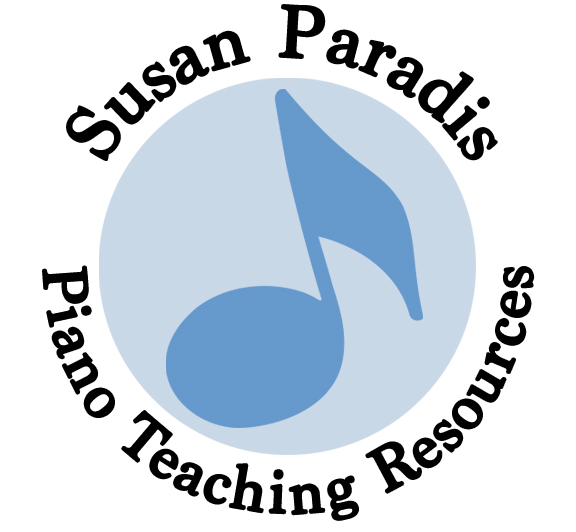Studio Technique Program

If you have trouble getting students to practice scales and arpeggios, maybe you can start a step-wise technique certificate program. Most students will practice more diligently when they have a goal. It is a well-known fact that long and short time goals motivate and inspire us. Boy Scouts and Girl Scouts, and even adult organizations have goals for their members.
With this in mind, some years ago I created a technique certificate program that has really helped in my studio. When a student completes a level, he is awarded a certificate at the recital. Many times a student will work extra hard to complete a level so he can get his certificate at the recital. Now technique is not a boring exercise to do before playing real music, but an attainable goal that each student can reach.
Some teachers are fortunate to participate in state or national programs that require technical proficiency. If so, you certainly do not need to start one of your own. But other teachers do not have the opportunity to participate in this kind of program, or want something simple and free. The only thing my program costs is the ink and paper to print a certificate.
If you would like to start this in your studio, you must first decide what technical exercises you want your students to learn. Then divide your list into levels. This is your program, so you may have as many levels as you wish.
A lot of music teachers are very detailed oriented. That is how they got to be great musicians in the first place. But most students are not, and if you make an elaborate program their eyes will glaze over. I know mine do!
Therefore, I think it is better to keep it simple. That way you can personalize it for each student and more students can succeed. You can always require specific metronome markings on a case-by-case basis with your students and not have it part of the certificate program. Some students play scales hands together and some do not. As teachers, we know the students who need a challenge. You can always modify it later on.
The following is a suggestion for a technical certificate program that you can modify to suit yourself. Level four and above can be customized for the student, with some also working on arpeggios and inversions. Students who plan to study music in college will need a stepped up program, but it does not have to part of your studio certificate program unless you want to.
Level One: Major Five Finger Scales, stepping, and skipping and a tonic chord
Level Two: Minor Five Finger Scales as above
Level Three: Simple hand-crossing arpeggios in all major and minor keys
Level Four: Major One Octave Scales ending with a chord progression I IV I V7 I
Level Five: Harmonic Minor One Octave Scales with a chord progression
Level Six: Major Two Octave Scales, inversions, and arpeggios
Level Seven: Minor Two Octave Scales, inversions, and arpeggios
I made this certificate to post today for teachers who are not handy with a graphics program or don’t have time. It is a PDF document for you to write in the student’s name and technique level by hand.




Susan,
I just love your website and your ideas. My local keyboard teachers group has done a similar thing for about 15 years that we call piano gymnastics. Students play 5 finger patterns, chords, arpeggios, scales and cadences at different levels for ribbons. If a student achieves the highest level at all the events (there are 8 plus a theory test), they earn a plaque with their name engraved. I would be happy to send you the word document with the events and levels explained. Keep up the wonderful work and inspiration!!
Thanks Faye!
Yes, please send me your association’s program, and let me know if I can share the levels with other teachers on my blog. My association has many events, but we don’t have one for technical achievements.
Dear Susan,
This is an admirable list of technique steps!
I just want to add that the cadence requirement (I-IV-I-V7-I) ought to start with a simpler one: e.g. V-I, then IV-I, then I-V-I, I-IV-I, I-IV-V-I, then V7-I, before requiring the student to suddenly jump into I-IV-I-V7-I.
Also, before the cadences can be taught, the student must know how to play triads and inversions first.
Great post!
Ivea
Ivea, that is quite true! I was assuming this post would be for an experienced teacher who would not try to teach it all at once, and also to give teachers some ideas for their technique certificates. I hope my post didn’t give the impression that this was quick and students would suddenly jump into cadences without prior care and attention to teaching them!
Susan, thank you for this–I love it, and my students will really benefit from learning technique in this encouraging way!
Susan,
You continue to amaze me! Fantastic ideas.
Your friend in Greenville, SC